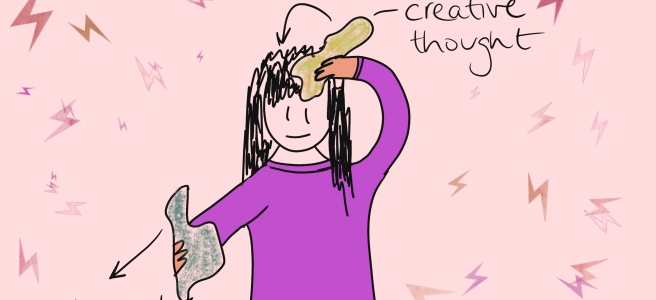I’ve finished reading a book, “Chatter“ by Ethan Kross. It’s about the voice in our head – not the voices, plural, that would’ve been a different kind of book.
As far as I remember (I’m terrible at remembering content – a film, a novel, I forget all about them once I reach the end), the book is all about how to control or make use of those conversations we have with ourselves. It’s a great pop psychology book, with anecdotes, research and advice.
Maybe I’ll share more about it here one day, but for now, I want to share how I directed “the voice in my head” away from ruminating and into creating.
I’m currently involved in a work project that constantly draws my thoughts to it. This annoys me because the direction of the project isn’t under my control and I’ve already given my own role as much thought as it needs. But my mind keeps playing back emails about it, conversations and designing possible future scenarios of how it might pan out.
After yoga on Friday, I found my mind absorbed in conversation with myself about this project, until I said to myself, “I don’t want this to take up my time. What can I think of instead?“

My little novel came to mind.
(Those subscribed to my newsletter, might remember it’s a cozy mystery).
Any time I want to abandon a series of thoughts, I think about the novel, about its characters, about the plot. I find it relaxing. After all, the stakes are low with those thoughts as they are about events and people that don’t exist, and there will be no consequences regardless of what I think about it. (At this stage I’m so far from publishing it, that there are really no consequences.)
I directed my attention to the scene that had kept me busy over the last week, Monday to Thursday at around 8am, for half an hour. The draft scene was about 2,000 words and needed reviewing: checking if it still made sense within the plot, which has developed lately, and adding little bits and pieces.
Not much happens in this scene. The main character (the amateur detective) was meeting her best friend, and it was the first time she’d spoken to her since she’d found the dead body. It gives the main character the chance to speak out loud how she feels about the whole crime, mainly the fact that she feels guilty for being excited, excited about being involved in a murder!
Back to the moment when all the thoughts about the work project threatened to take over my mind, I shifted my attention to that scene and asked a classic writing question: why is the friend there?
“Yes, she’s helping the main character process some of what’s going on, but initially she was there with her own subplot. But the subplot wasn’t going anywhere, so I dropped it. This meant that the friend had no real reason to be in that scene.
But what if the friend is there to talk about a guy she’s recently started going out with?
But how is that related, why would it be of interest?
What if he’s a drug dealer?
But she doesn’t know he’s a drug dealer?
What if she thinks he’s seeing someone else because his behaviour is shifty, but really he’s dealing drugs.”
Now I had a new subplot that could add to the story: it’s full of conflict, potential mystery and overlaps slightly with the main plot, where drug dealing is considered as a motive for the crime.
This scene had been causing me trouble all week.
I hadn’t been able to fix it through outlining, or by following a writing prompt.
I solved by deliberately thinking about it just to distract myself.
Such is the creative process: you can’t control it, but you need to put the time into it, in whatever form you can.
I’ve gone back to the book about the voice in our heads, Chatter, to see if there was a relevant quote to share with you.
I found this:
“We use our minds to write the story of our lives, with us as a main character.”
And every now, and then, I will add, we use it to write the life of someone else.

